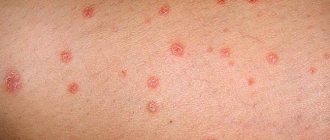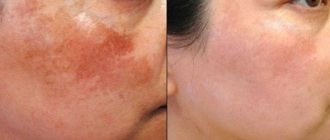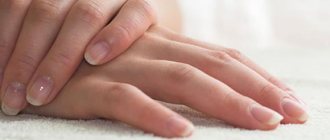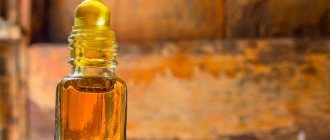Compound
Sulfur ointment is a viscous substance of yellow or light yellow color. The drug consists of sulfur itself and auxiliary components in the form of a mixture:
- soft white paraffin,
- purified water,
- emulsifier T-2.
Soft white paraffin, also known as Vaseline, included in the composition, enhances the healing effect due to its own softening and protective properties. The ointment appears to be homogeneous in composition; small grains are felt to the touch. The concentration of the active substance is 5, 10, 20 or 33% depending on the release form. It goes on sale in dark glass jars or tubes of 25, 30, 40 grams and is sold without a doctor's prescription.
Simple sulfur-based ointment is available in two types: 10% and 33%.
The therapeutic effect is achieved due to the properties of the active substance (precipitated sulfur).
For better absorption of the active compound by the tissues and cells of the epidermis, a consistent emulsion consisting of petroleum jelly and water is also used in production.
Product description: medium density substance, light yellow color, specific smell.
Pharmaceutical companies produce analogues that have a combined composition.
In addition to sulfur, it contains:
- salicylic acid (main purpose – psoriasis, seborrhea);
- birch tar (main purpose – scabies).
Features of the impact
There are many reasons for the appearance of dandruff in humans, but the main one is disruption of the functioning of the sebaceous glands. Such a lesion in the medical field is called seborrhea.
An incorrectly designed diet, regular stress and emotional stress, diseases of internal organs, damage to the digestive and endocrine systems - all this provokes the appearance of dandruff. If you do not begin timely treatment of the lesion, then the person risks losing some of his hair in the future.
To eliminate dandruff, seborrheic dermatitis and other diseases of the scalp, which cause severe burning and white scales, special creams, shampoos, sprays, tablets, and lotions are used.
But the most common and effective remedy for combating dandruff among doctors continues to be ointment. Anti-dandruff ointment is a medicine of varying consistency. It may contain active ingredients and other medicinal substances, plant extracts, mineral components and vitamins. The formula of the drug helps not only to get rid of unpleasant symptoms and eliminate the process of skin peeling, but also to enrich skin cells with nutritional components, improve the condition of the immune system, restore metabolic processes and the functioning of the sebaceous glands.
Depending on the active component in the base of the product, there are 4 groups of medicinal ointments against dandruff:
- The first group is products with tar, climbazole, ketoconazole, octopirox and sulfur. Their effect helps reduce the activity of pathogenic bacteria and fungi in the upper layers of the skin, leading to their gradual death.
- The second group is preparations with zinc pyrithione. Such substances quickly dissolve in the sebaceous glands and have an antifungal effect. They help improve skin condition, reduce flaking and relieve symptoms of dermatological lesions.
- Third group. The active ingredients most often used are salicylic acid. The effect of this product helps to quickly exfoliate dead skin cells and ensure active regeneration of new skin cells. Medicines from this group are prescribed to patients with seboria and psoriasis.
- The fourth group is medicinal products that contain resin of pine, juniper, cedar, as well as calendula and chamomile extract. The natural components in the composition have a calming effect, help eliminate the inflammatory process and restore the functioning of the sebaceous glands. Such components actively fight bacteria and fungi and also help stop their spread.
Local preparations are applied in a thin layer to the diseased area of the body, which helps protect the skin from the spread of the disease and provokes the death of the infection.
It should be noted that ointments to eliminate seborrheic dermatitis are simply applied, do not spread and help eliminate the infectious process. The drug is used sparingly, and its cost is affordable for everyone.
Sulfur-salicylic ointment
The composition of the ointment with salicylic contains significantly less sulfur than simple sulfur ointment. It contains only 2g 100g base (2%). In addition to sulfur, the ointment also contains 2 g of salicylic acid. It significantly enhances the antibacterial and antiseptic effect. It also regulates the secretion of sebum, which provides a drying effect.
In addition, salicylic acid penetrates deeply into the skin and causes increased blood circulation. What accelerates tissue regeneration.
Sulfur-salicylic ointment cleanses pores and dries out inflammation. However, the composition with salicylic acid is irritating. Therefore, it is used for oily skin and not for dry skin. For dry skin, a simple one-component ointment with sulfur is better suited.
Salicylic acid is often used to treat acne. It can cause a burn (if applied as a compress) or dry out the skin too much (if you frequently wipe your face with acid or alcohol). Therefore, they began to use salicyl in a complex manner, adding it to preparations along with other components.
The list of diseases for which sulfur-salicylic ointment is used includes juvenile acne, ringworm, mites under the skin and demodicosis.
Now let’s look at what sulfur ointment helps people with.
“System 4” in the fight against dry and oily seborrhea
This is a Finnish program to get rid of all types of seborrhea and to stop hair loss.
Consists of a therapeutic scalp mask, shampoo and tonic. The mask contains salicylic acid and antifungal components. Relieves the symptoms of even advanced seborrhea after the first use. Heals and normalizes the activity of the sebaceous glands.
The medicated shampoo and tonic also contain antifungal components.
“System 4” against seborrhea is very good; trichologists often prescribe it to their patients. The main disadvantage is the high cost: a course of therapy with System 4 will cost the patient approximately three thousand rubles for one month of use.
Sulfur ointment for parasitic mites: scabies
Scabies is a parasitic disease in which a microscopic insect, a mite, settles on human skin. The main unpleasant symptom of the disease is severe itching, which accompanies the appearance of parasites. In addition to itching, a small pustular rash appears.
Scabies is transmitted through close contact. To become infected with this parasite, prolonged “body-to-body” contact is required. Therefore, many modern doctors consider scabies a sexually transmitted infection.
Treating scabies with sulfur ointment was popular fifty years ago. Sulfur treatment is still prescribed in post-Soviet countries. European medicine uses other, more aggressive means.
In order to remove ticks with sulfur ointment, in the evening before bed it is applied to the entire surface of the body. For children, the ointment is even rubbed into the face and under the hair.
After sulfur ointment, you should not wash for 24 hours. Afterwards, if necessary, you can take a shower, dry the skin and reapply the ointment.
The choice of concentration of sulfur ointment for scabies is determined by age. For children it is recommended to use a 10% composition, for adults - 20% sulfur ointment. The duration of treatment is a minimum of 3 days – a maximum of 7-8 days. After a week, the person is considered cured.
Sulfur ointment and demodicosis
In addition to the well-known scabies mite, a person’s skin can become infected with another mite-borne parasite - the glandular acne. This microscopic insect settles in the ducts of the sebaceous glands and hair follicles. The ironweed prefers the skin of the face, settling on the forehead, chin, nasolabial folds, eyelids and in the outer part of the ear canals.
Infection with this parasite occurs unnoticed. Its appearance is accompanied by the sudden development of large pink pimples on the face. The skin infection becomes chronic and periodically worsens (during the off-season - spring, autumn).
Ironworm infection is called demodicosis. The use of sulfur ointment for demodicosis consists of applying it to the face twice a day (morning and evening). Treatment periods are long, from one to three months.
Instructions for use
General recommendations for using a dermatological product:
- the affected areas are treated with medicine 2-3 times a day;
- The ointment should be applied exclusively to the focal area, the surface of healthy skin is affected only 1-1.5 cm at the edges;
- a thin layer of medicine is formed (it is rubbed in in a circular motion);
- The duration of therapy is determined by the attending physician (on average, the course lasts 3-10 days).
The method of treating lesions depends on the nature of the disease. For minor lesions, the ointment is applied once a day; the presence of large areas requires frequent procedures (up to 3 times a day).
Before carrying out the treatment procedure, the skin on which the pathological manifestations are located is washed with soap and dried with a towel.
The medicine is distributed only over dry skin.
For one-time processing, you should choose the evening time. Throughout the night, the active components will work in the outbreak, fighting the pathological process.
There is no need to rinse off the product before going to bed.
Scabies
To combat subcutaneous mites, ointment is used in a concentration of 10%. The skin of the entire body is subject to treatment.
The medicine should be applied for three days in a row (at night).
You should not take a bath or shower these days.
Clothes must be changed every time. Simple washing does not have an antiparasitic effect, so underwear is boiled or disinfected in another way.
With scabies, the mite most often affects the area between the fingers. After using the medicine, it is not recommended to wash your limbs for at least 3 hours.
Pediculosis
The medicine has a weak effect on lice, and practically no effect on nits.
But due to its safety, the ointment is recommended for children over 3 years of age.
Rules for using the ointment:
- before treatment, the medicine is diluted with water in a ratio of 1:1;
- using a cotton pad, apply to the scalp and the entire length of the strands;
- leave under a plastic cap for 30-40 minutes;
- wash off using shampoo and rinse with water and vinegar (the components are diluted in a 1:1 ratio).
Repeated procedures should be carried out after 3-4 days.
Dermatitis
The procedure schedule is 2 times a day.
Duration of therapy is 3-7 days. It is recommended to use 5% ointment.
Fungal infections
Focal areas of the body are treated 1-2 times a day.
For 5 days, taking a bath or shower is prohibited, but clothes will need to be changed daily.
At the end of the period, the remnants of the ointment are washed off and clean underwear is put on. All removed clothing must be disinfected.
Sulfur ointment owes its healing properties to sulfides and pentathionic acid, which are formed when sulfur reacts with organic substances in the skin. Thus, it has antimicrobial, antiparasitic and antifungal properties, as well as the ability to restore the affected areas of the upper layer of the skin - the epidermis.
The concentration of sulfur ointment is of great importance. With a low percentage of sulfur, it will promote the healing of small wounds and defects that have arisen on the affected skin and activate the formation of new cells. Quite quickly after the start of treatment, the inflamed areas stop itching.
The use of 33 percent sulfur ointment allows you to loosen the upper layers of the skin with subsequent removal of dead areas, for example, with seborrhea. This process is facilitated by irritation of skin receptors, which leads to improved blood supply to the treated areas. This speeds up metabolism in the epidermis and speeds up recovery.
The choice of concentration of the ointment, as well as the scheme of its use, depends on the specific skin disease, the severity of the disease and requires consultation with a specialist. With its help you can successfully treat:
- scabies,
- lichen,
- various dermatitis,
- seborrhea,
- eczema,
- psoriasis,
- demodicosis,
- fungus.
The term dermatitis combines a group of skin pathologies that manifest themselves in response to various irritants in the form of rashes, redness and itching. Such manifestations are usually based on an allergic reaction, therefore, using sulfur ointment, you can relieve irritation, reduce inflamed areas, and with a weeping form - reduce pain as a result of the drying effect. However, a disease can be completely cured only after its cause is eliminated.
Seborrheic dermatitis most often affects the scalp, although it can also appear on other areas of the skin. The disease is associated with increased secretion of the sebaceous glands. Severe peeling, accompanied by itching, leads to the formation of crusts, which can often be observed in newborns.
It should be remembered that the disease is not as simple as it seems. It is provoked by gastrointestinal problems, disorders of the nervous system, hormonal imbalance, and stress. Therefore, as with any other dermatitis, other strong drugs, including hormonal ones, will be needed for treatment.
Eczema is characterized by various skin lesions: from itchy, weeping blisters to profuse redness with dry cracks, accompanied by a burning sensation. Proceeding in an acute or chronic form, it has a cyclical nature, either subsiding after treatment or exacerbating again. Particular mental discomfort is caused by frequent damage to open areas.
Sulfur ointment for eczema creates a protective barrier against the penetration of pathogenic microorganisms through inflamed areas and can be used not only on the hands, but also on more delicate areas - the face and neck. In the weeping form, sulfur-zinc ointment has a powerful antiseptic effect.
There are many methods and special medications for the treatment of seborrhea, which, when properly prescribed, give remarkable results. One of the favorite forms of medications for seborrhea are all kinds of ointments. The popularity of such funds is explained by several factors:
- Disinfect the surface
- Suppresses the growth of various fungi
- Softens dry crusts, promoting their healing and elimination
- Activate the healing of the epidermis
- Accelerate the formation of new skin cells and, accordingly, renewal of the skin
- Cleans the surface of dandruff.
In addition to therapeutic effects, the advantage of ointments for seborrhea is their affordability and the availability of a variety of drugs in pharmacies: from the simplest to the latest developments.
The disadvantages of ointments include a specific, not always pleasant smell, difficulty in rinsing, as well as a long treatment period. But even with these difficulties, the effect of using ointments for seborrhea still outweighs their disadvantages.
The antiseborrheic effect of the ointment is achieved by the properties of its main component - sulfur. The substance is famous for its strong anti-dandruff effect and inhibitory effect on various pathogenic microorganisms.
After application to the skin, it penetrates into the layers of the dermis and, under the influence of the organic acids present, forms sulfides and pantothenic acid, which have a powerful antimicrobial and antiparasitic effect.
Sulfur ointment for seborrhea is prescribed in complex, advanced cases when previous treatment has not had a positive effect. In these cases, an ointment with a 33.3 percent sulfur content is used; for milder cases, an ointment with a lower sulfur concentration (10%) is used.
The advantage of the drug is that it does not dry the skin, so it can be used on any type of hair, but a particularly strong effect is manifested with dry and mixed hair.
Sulfur ointment relieves dandruff by suppressing the increased activity of fungi, eliminating the inflammatory process and at the same time promoting the healing of damage and normalization of the skin.
The duration of therapy should be determined by the treating specialist, but generally it is 2-3 weeks. The ointment is applied daily to previously washed and dried scalp, left for 5 minutes, then washed off. After a week-long course, you need to take a break for at least a day, and then resume treatment.
During procedures, it must be taken into account that the sulfur contained in the ointment is highly toxic. Therefore, it can cause irritation of mucous tissues and respiratory organs.
In people with normal immunity, the ointment does not provoke negative side reactions. They are possible only in patients with a high level of sensitivity to the components of the ointment. In this case, there is a burning sensation in the areas where the ointment is applied, itching and other individual symptoms. When they appear, sulfur ointment is canceled.
It is highly undesirable to use the ointment longer than prescribed by the doctor, so as not to aggravate the skin condition. If sulfur ointment for seborrhea does not help, then it is better to undergo additional examination and find out the actual cause of the pathology.
A cheap and effective remedy for various skin lesions. The ointment can be used to treat burns, skin inflammation, acne, scabies, and of course, seborrheic dermatitis.
The effect of the main component of sulfur is enhanced by the inclusion of salicylic ointment in the composition. The concentration of substances is 2% and 5%. Thanks to the interaction of two substances, the ointment has a combined effect:
- Has antiparasitic and antimicrobial effect
- An ointment with a small content of substances accelerates tissue regeneration, a more concentrated product helps soften and more easily separate keratinized scales.
Sulfur has an anti-dandruff effect, suppressing the activity of microorganisms, salicylic acid enhances its effect, relieves inflammatory processes on the skin and disinfects.
For seborrhea, it is recommended to use 2% ointment. It is applied to the scalp and left for 2-3 hours. There is no need to cover your hair with anything so as not to interfere with the functioning of the follicles. After this, the drug is washed off with neutral shampoo. It is recommended to use sulfur-salicylic ointment for seborrheic dermatitis for at least a month.
Such treatment is usually well tolerated by the body if the patient is not allergic to sulfur and salicylic acid. For some people, the ointment may cause itching and dry skin. If unpleasant sensations occur, it is better to discontinue the medication and consult a doctor to determine further actions.
Shampoo Friederm pH balance
pH-balance shampoo does not contain artificial ingredients, fragrances, preservatives or dyes - it contains exclusively hypoallergenic neutral components that delicately care for any hair.
With proper and regular use, the scalp will be well cleansed, the process of controlled sebum production will be normalized, and shine will appear. The shampoo is most popular among people with skin and allergic diseases, the instructions are indicated directly on the packaging, and the price and positive reviews indicate that this choice will be the right one. The product normalizes the balance of the scalp and hair, maintains the required level of acidity, and deeply cleanses. It is suitable for strands that have become too fragile and brittle after frequent dyeing and curling.
Friderm with tar
Friederm shampoo, which contains purified coal tar and other beneficial substances, has a powerful anti-inflammatory and antifungal effect, stops excessively active exfoliation of skin cells, thereby preventing the appearance of dandruff. Tar helps to noticeably reduce sebum secretion.
Most often, this remedy is used as prescribed by a doctor in cases where patients have psoriasis of the scalp, oily seborrhea, etc. Tar is effective in such cases, eliminates dandruff, returns softness and shine to the strands. Instructions for use are quite simple: you need to use tar twice a week. Before use, shake Friederm shampoo thoroughly, apply to wet hair and rub. Leave for literally five minutes, rinse and rinse. After this, the smell caused by tar will disappear.
When treating oily seborrhea, it is necessary to wash your hair with tar at least 8 times (up to 30 or more); for psoriasis – this is 16–25 times. After some time, the course can be repeated for preventive purposes. After all the signs of the disease have been overcome, the product is replaced by its “neighbor” in the line - Friederm pH balance. The only contraindication may be individual intolerance to tar.
Shampoo with zinc
Reviews and studies confirm that Friederm shampoo, which contains zinc, is a real salvation for problems with hair and scalp. It suppresses the activity of streptococci and staphylococci, eliminates dandruff, improves hair structure, and neutralizes painful skin reactions and allergies. Zinc is very effective in the fight against seborrhea. The drug collects a lot of positive reviews, most of which indicate its active therapeutic effect.
The active substance – zinc – has a bacteriostatic effect, slows down the proliferation of bacteria and fungi, relieves inflammation and itching, and normalizes cellular processes.
The product can be used for therapeutic and prophylactic purposes. The course of treatment is two weeks. You need to wash your hair with products containing zinc twice every 7 days. For preventive purposes, shampoo is used once a week, but at this stage it is better to replace it with Friederm pH balance, since excessive use of zinc may cause dry skin.
Sulfur ointment for nail fungus
Fungal infections of the skin and nails are also treated with sulfur ointment. It is applied to the nail plate and adjacent areas of the skin once a day (at night, after a bath, just before bed). The treatment period for fungus with sulfur ointment is about a week.
Sulfur ointment is universal. Its composition acts against various fungal infections. However, it may not be effective enough. In this case, sulfur ointment is replaced with a more aggressive drug - sulfur-salicylic ointment.
Other ointments for fungus
Seborrheic dermatitis cream
Seborrheic dermatitis is not considered a serious disease, but it causes significant discomfort to a person. Ointment for seborrheic dermatitis on the head will help cope with the problem.
However, you should not be careless about the symptom, because it signals more serious problems with the body, ignoring which we risk a relapse of dermatitis or even worsening in the form of eczema and psoriasis.
Causes and symptoms of the disease
Seborrheic dermatitis in the initial stages looks like dandruff or flaking of the skin, over time it forms red patches with crusts that cause itching and hair loss.
This occurs due to the pathological proliferation of microorganisms of the natural microflora of the skin, provoked by disruption of the sebaceous glands. Before prescribing an ointment against seborrheic dermatitis, find out the cause of the failure of metabolic processes in the body.
There are many reasons for such violations, and to resolve the problem, it is necessary to undergo tests and consult a specialist. The following reasons are usually identified:
- stress;
- obesity;
- digestive problems;
- parasites;
- hormonal imbalances;
- disruption of the endocrine system;
- allergy.
When are ointments used?
The use of ointment eliminates the unpleasant symptoms of the lesion.
Treatment of seborrheic dermatitis may involve the use of hormonal agents, vitamin complexes, and antihistamines.
As a rule, doctors recommend eliminating contact with potential allergens - junk food, plants, toxic substances. Shampoos, ointments and creams against seborrheic dermatitis help solve the cosmetic problem.
To choose an ointment to eliminate the external manifestations of the disease, you need to determine the type of seborrhea:
- An itchy sensation and a large amount of white, dust-like dandruff in the hair are signs of dry seborrhea.
- Large white flakes and wet patches of skin indicate oily seborrhea.
- The mixed type can be in the form of dry seborrheic dermatitis on the face and oily on the scalp.
Types of ointments for the treatment of seborrheic dermatitis
Uncontrolled use of hormonal ointments can lead to serious complications and chronic allergic reactions.
Creams and ointments used in the treatment of seborrheic dermatitis are divided into two groups: non-hormonal and hormonal.
Non-hormonal antifungal drugs for dermatitis are used to treat children, pregnant and breastfeeding women. If such therapy does not bring results, hormonal ointments are used.
They are used for short periods of time due to habituation and potential harm to the fetus or nursing infant.
"Lamisil"
Before applying the product, the skin must be cleansed with an antibacterial agent.
Gel based on 1% terbinafine, available in volumes of 15 ml and 30 ml, is suitable for the treatment of fungi of the skin, nails and hair. Improvement from Lamisil can be noticed within a few days; the general course of treatment lasts 3-5 weeks.
Apply a thin layer of cream to dry and clean skin 1-2 times a day, suitable for the treatment of oily seborrhea. The components of Lamisil penetrate into the blood and are excreted in breast milk, therefore therapy is incompatible with breastfeeding and is contraindicated in children under 12 years of age.
Sometimes side effects appear in the form of burning and redness.
Zinc ointment
The best anti-inflammatory, drying and antibacterial agent based on 10% zinc oxide. Available in various volumes and packaging.
Creates a protective film on the surface, Vaseline included in the composition softens and nourishes the skin. Zinc ointment is not an antifungal agent, but it can relieve irritation and itching.
Effective for the treatment of children's prickly heat, rashes and dermatitis. For therapy, apply 1-3 times a day until recovery.
Salicylic ointment
A drug of the keratolytic group, the active ingredient is salicylic acid. Has a powerful antiseptic and anti-inflammatory effect. Available in different concentrations of salicylic acid - 2, 5, 10 and 60%.
Salicylic ointment works especially well for oily seborrheic dermatitis. Apply it to the affected area at night, treatment lasts from 1 to 3 weeks.
Not suitable for treating people with renal failure and infants.
"Ketoconazole"
The use of the drug is contraindicated during pregnancy.
Antiparasitic agent with the active substance ketoconazole.
Ketocanazole is very effective in fighting fungal infections, therefore it is included in most anti-dandruff and seborrhea products. For the treatment of seborrheic dermatitis, apply a medium layer to the plaque area, extending 2 cm beyond its borders, 1 r.
per day until complete healing. Not used to treat children and pregnant women, patients with liver and kidney problems.
Other non-hormonal drugs for dermatitis
| Name | Active substance | Properties | Contraindications |
| "Eplan" | Triethylene glycol | Disinfectant | No |
| Wound healing | |||
| Painkiller | |||
| Emollient | |||
| "Exoderil" | 1% naftifine chloride | Antifungal | Children |
| Antibacterial | Pregnant and lactating women | ||
| Anti-inflammatory | Open wounds | ||
| "Skin-up" | 0.2% zinc pyrithione | Calming | Intolerance |
| Antipruritic | |||
| Antifungal | |||
| "Losteril" | Naftalan | Exfoliating | Age up to 3 months |
| Antimicrobial | |||
| Propylene glycol | Anti-inflammatory | ||
| Regenerating | |||
| "Bepanten" | dexpanthenol | Emollient | Intolerance |
| Painkiller | |||
| Anti-inflammatory | |||
| Antiseptic | |||
| "Apilak" | Apilak | Emollient | Allergy to bee products |
| Disinfectant | |||
| Regenerating | |||
| "Clotrimazole" | 1% clotrimazole | Antifungal | 1st trimester of pregnancy |
| "Zinocap" | 0.2% zinc pyrithione | Antifungal | Children under 1 year |
| Anti-inflammatory | |||
| Antibacterial | Intolerance | ||
| "Elidel" | Pimecrolimus | Anti-inflammatory | Age up to 3 months |
| Healing | |||
| Calming | |||
| "Baneotsin" | Neomycin sulfate | Antimicrobial | Pregnancy |
| Bactericidal | Lactation | ||
| Painkiller | Intolerance |
Safe drugs for pregnant women
Toxins are dangerous to the fetus.
Due to the toxicity of many ointments for seborrhea, especially hormonal ones, pregnant women need to be very careful when choosing medications.
The best products, consisting mostly of natural ingredients, are sulfur ointment and zinc ointment.
Among other drugs, Bepanten cream, Eplan, Metrogyl and Curiosin gels, Apilak are considered safe; After examination and consultation, the attending physician may prescribe Nizoral cream.
Contraindications and side effects
External hormonal preparations have general contraindications and limitations in use.
Hormonal antifungal drugs should not be used for more than 12 weeks in a row and are not suitable for treating facial skin rashes.
It is prohibited to use for patients suffering from tuberculosis, scabies and sexually transmitted diseases. It is strongly recommended not to use the medication during pregnancy or under 7 years of age.
Source: https://EtoGribok.ru/seboreya/maz-ot-seborejnogo-dermatita.html
Sulfur ointment for face
The use of sulfur ointment for the face is explained by its keroplastic properties. Sulfur sulfide helps exfoliate old skin cells and form new ones. This maintains the elasticity of the skin and the youthfulness of the face.
In addition, the antiseptic properties allow the ointment to be used for various types of acne. Sulfur ointment for acne on the face helps cure medium acne (pimples). Severely inflamed acne requires more aggressive medications.
By using sulfur ointment for acne, we also regulate the functioning of the sebaceous glands. Sulfur normalizes the secretion of sebum, on which pathogenic bacteria multiply. This also affects the number and size of acne - there are fewer of them.
Sulfur ointment is a simple preparation that combines several cosmetic properties. It prevents the proliferation of bacteria (it is their metabolic products that clog pores with “blackheads”). It dries out inflamed pores (in the accumulations of which infection multiplies). It also exfoliates dead cells (which accumulate in the recesses).
Does sulfur ointment help against wrinkles? No, the sulfur composition has antiseptic properties and a slight keratolytic effect, but it is not able to remove even small expression wrinkles.
Traditional recipes for the treatment of seborrhea of the scalp
List of the most popular folk recipes for ointments for seborrhea of the scalp:
- Mix a teaspoon of coconut oil, a teaspoon of burdock oil with a tablespoon of salicylic paste, mix thoroughly until a homogeneous consistency is formed. Apply part by part to affected areas of the scalp. Wash off after half an hour with cool water using medicated shampoo.
- Mix chamomile juice with calendula decoction (20 ml of each ingredient), add a little burdock oil. Carefully apply the resulting liquid ointment along the partings using a cotton pad. The duration of exposure is about an hour.
- Garlic ointment helps reduce sebum production. Grind two or three cloves of garlic through a garlic press or in a blender. Add a couple of teaspoons of olive or castor oil. Gently apply the resulting composition to the affected area of the scalp and rinse off an hour after application.
- Mix the following ingredients in equal proportions: olive, castor and burdock oil and sulfur ointment. Mix thoroughly until a homogeneous consistency is formed. Apply part by part to affected areas of the scalp. Wash off after half an hour with cool water using medicated shampoo.
Sulfur ointment and pregnancy
Clinical trials have not been conducted for this category of patients.
Theoretically, the composition cannot cause harm to the health of the woman and the fetus. In case of urgent need, the drug can be used for the treatment of dermatological diseases, but in agreement with the doctor managing the pregnancy.
It is important to read the package insert before using for the first time. Attention is paid not only to the question of what the ointment is used for, but also to its ability to provoke an allergic reaction.
You can check this using a test: apply the product to the back of your hand and leave for 10-15 minutes.
The absence of redness or burning is evidence of the safety of the drug.
During lactation, the sulfur composition can be used on different parts of the body, except the chest.
Sulfur ointment for acne
Experts recommend using sulfur ointment with a concentration of 10% for acne on the face.
This composition has a gentle effect on the skin and subcutaneous processes.
Sulfur quickly penetrates the layers of the dermis and destroys pathogens. The first contact with the skin is accompanied by a slight burning sensation, which disappears after 2-3 minutes.
The composition with an active substance content of 33% is suitable for eliminating acne and treating old scars.
This type of ointment acts more aggressively, but the effect is worth it. The only caveat is not to use it on your face.
No trace remains of serious lesions after a course of treatment.
To prevent the development of adverse reactions, it is recommended to first read the instructions. This is especially true for the sections: indications for use, how to carry out procedures and contraindications.
It is not worth carrying out the procedure frequently; the sulfur composition dries out the skin.
Contraindications
There are a number of contraindications to the use of this drug:
individual intolerance to the components contained in this drug;
- age up to 3 years;
- anemia;
- simultaneous use with drugs that have the ability to oxidize (hydrogen peroxide or potassium permanganate) - to avoid getting a burn of chemical origin.
Avoid contact with mucous membranes during treatment of psoriasis with sulfur ointment.
Sulfur ointment for seborrhea
The disease usually first appears in adolescence and can recur regularly throughout life. The exact causes of the pathology have not yet been established, but it is assumed that seborrhea occurs due to hormonal imbalance in the body, heredity, and disturbances in the functioning of the gastrointestinal tract. But most often the culprits are various pathogens.
Damage to the scalp is one of the types of chronic dermatitis. Basically, the pathology is provoked by microorganisms present in the human body. In a normal state of immunity, they usually do not manifest themselves, but as soon as internal failures occur and, as a result, favorable conditions are created, they begin to actively reproduce.
Favorite places for the formation of colonies of microorganisms are areas of the skin with a large accumulation of sebaceous glands, which, under the influence of certain factors, produce large amounts of sebum. Therefore, the development of seborrhea (seborrheic dermatitis) usually occurs in the upper part of the head. The disease can also affect the skin of the face, upper back and chest.
The success of treating seborrheic dermatitis, like any other pathology, depends on the correct determination of the type of disease. There are several types of disease:
- Dry type of seborrhea: manifested by abundant, loose, white dandruff. Accompanied by severe itching in the affected areas, dryness and brittleness of the hair shafts.
- Oily type: characterized by overactive sebum production by the sebaceous glands. Therefore, the hair quickly becomes covered with plaque the very next day after washing your hair. A scattering of yellowish scales appears on the head, the skin itches and itches.
- Mixed type of seborrhea. It is characterized by a combination of dry and oily types of seborrhea in different areas on the scalp.
The use of ointment by pregnant and lactating women is not recommended, but it is possible if necessary. In these cases, use an ointment with a 2% content of components.
In the complex treatment of seborrhea of the scalp, it is necessary to take into account the ability of Sulfur-salicylic ointment to enhance the effect of other external agents due to the locally irritating effect it produces. In addition, the ointment should not be combined simultaneously with medications that contain resorcinol and zinc oxide. Otherwise, no particularly negative consequences of combination with other drugs are mentioned in the instructions for the drug.
The use of hair ointments for seborrhea helps get rid of the infection and normalize the functioning of the sebaceous glands. But despite their effectiveness, the success of treatment also depends on other factors: correct diagnosis, selection of the most effective drugs and systematic implementation of medical prescriptions by patients.
Seborrhea is a fungal skin disease that is simply called “dandruff”. The cause of seborrhea (or seborrheic dermatitis) is a fungal infection of the skin in the scalp. It is manifested by itching and flaking, while small particles of skin (dandruff) appear on the hair.
Sulfur can cure fungal infections. To do this, sulfur ointment is applied to the skin between the hair once a day. Treatment time is 7-10 days.
Folk remedies
Since ancient times, ointments have been an indispensable tool in the piggy bank.
healers' remedies
Based on tar, pine buds, oak bark
... century after century this knowledge developed, new recipes appeared.
With the advent of pharmaceuticals, ointments still occupy a dominant place in the treatment of various diseases, in particular, all kinds of ointments are actively used to treat seborrhea.
The undeniable advantages of ointment compositions are the following:
- Healing effect. The cause of peeling is damage to the upper layers of the epidermis. The viscous structure of the ointment allows you to start the process of cell regeneration, which is simply necessary in the treatment of seborrhea.
- Many formulations are famous for their disinfecting, antiseptic, and antifungal effect.
- The softening property also falls into the category of positive properties.
But, like any drug, ointment formulations have disadvantages. The disadvantages of this treatment include the impossibility of therapy for oily seborrhea, as well as the difficulty of washing off the ointment.
Check out the reviews
effective
anti-dandruff shampoos
- cosmetic: Head {amp}amp; Shoulders, Clear Vita ABE, Alerana, Horsepower, Tar Shampoo;
- pharmacy: Nizoral, Sulsena, Sebozol, Fitoval, Ketoconazole, Vichy, shampoos with zinc.
Read tips on how to choose the right shampoo for a man or woman, as well as for dry or oily dandruff.
The use of alternative medicine is reduced to the use of sulfur ointment, essential oils or wrap masks.
Sulfur ointment fights seborrheic dermatitis well, eliminating fungal infection. It is a mixture based on an emulsion base that has an antiseptic and disinfecting effect.
With daily use for a week, the sebaceous glands and dandruff will decrease, and the hair will become less dirty. The use of ointment will have a greater effect together with tar shampoo, formulations with ketocanazole and selenium sulfide. To apply the ointment, rub it into the dry scalp, leaving it on the hair for 3-5 minutes, then rinse with warm water (see photo).
Treatment of seborrheic dermatitis in oily form is also carried out with essential oils. The most popular oils are lemon, eucalyptus, cypress, sage, grapefruit, rosemary and thyme.
It is enough to add one drop of tea tree essential oil to your shampoo to treat oily seborrhea. In combination with essential oils, it is worth rinsing your hair with a decoction of oak bark, burdock or plantain herb.
Wrap masks are widely used in the treatment of oily seborrhea, with a frequency of use once every one to two weeks. Before wrapping with a mask, the head should be washed clean, and the mixture itself should remain on the hair for about 15-25 minutes.
- A wrap mask based on yolk and castor oil copes well with the manifestations of fungus; additionally add onion juice and honey. Due to the use of onions and to avoid an unpleasant odor, you should wash your hair very carefully after the mask.
- The whites, whipped into a strong foam, are rubbed into the scalp, after which they are washed off with soap containing sulfur, preventing the active production of sebum.
- A yeast mask is prepared by mixing yeast with water to a paste consistency, after which beaten egg white is added. The mixture is rubbed into dry scalp, left for 15-20 minutes and washed off with warm water.
- Decoctions of walnut leaves and calendula flowers help to cope with oily seborrhea of the head. It is popular to rinse with a decoction of chamomile, calendula and plantain, which are mixed and poured with boiling water. After keeping in a thermos for 10 hours, the broth can be used. A decoction of burdock, St. John's wort and elecampane roots, which are mixed in equal quantities and poured with boiling water, can be used after 10 hours of infusion.
Interaction
Dermatological ointment is often included in complex therapy.
Depending on what it is prescribed for, combinations of drugs are selected:
- for dermatitis - sulfuric zinc ointment;
- for oily seborrhea - sulfur salicylic ointment;
- for scabies - sulfur permethrin ointment.
You should not combine pharmacological agents on your own due to a possible decrease in the therapeutic effect due to incompatibility of the compositions.
Features of the use of Sulsena products
A series of therapeutic products “Sulsena”: a mask (an orange oily ointment), shampoo and spray. Suitable for both dry and oily seborrhea. Sulsena products are very popular among patients due to their stylish packaging design and relatively low prices for the products in the series.
Ointment for seborrhea on the head should be used before washing your hair. It can be either very dirty or recently washed. It is not recommended to use Sulsena ointment on freshly washed hair. It is necessary to apply the product along the partings and gently massage into the scalp with your fingertips. Leave to act for half an hour. Then rinse with warm water using medicated shampoo.
Sulfur ointment for lichen
Usually the word lichen refers to fungal infections of the skin. This infectious disease in medical terminology is called microsporia or trichophytosis, and in the generally accepted version - ringworm. To treat it, you can use an inexpensive salicylic-sulfur composition. However, there are other, more effective means.
The sulfur composition has remained popular in the treatment of lichen in animals. Thus, veterinarians recommend using sulfur ointment for cats with large areas affected by lichen, if it is necessary to treat the entire body. It is also recommended to supplement treatment with internal antifungal medication.
Reviews
Snezhana, 42 years old, Tyrnyauz I use sulfur ointment everywhere. It's a little itchy - I apply it. It helps and costs a penny.
Ivana, 34 years old, Dzerzhinsk, treated her daughter’s lichen with sulfur ointment. The doctor prescribed treatment with iodine and sulfur ointment. He said that these simple remedies for lichen are time-tested. And that cheap drugs help no worse than expensive ones. Within a week, the lichen was gone.
Mikhail, 50 years old, Sapozhok village I read on the forums that sulfur ointment helps against fungus on the nail. I tried it. I applied it under the bandage at night and washed it off in the morning so it didn’t stink. After a week I noticed slight improvements. After two weeks it was already noticeably better. In general, I cured it, cheaply and cheerfully.
Artem Rodionovich, Kuznetsk Sulfur ointment against fungus helps at the onset of the disease. If the fungus is old, it will not help.
After a vacation in the village, three itchy red dots appeared on my son’s arm, which gradually increased in size.
The doctor gave a verdict - lichen. He suggested several drug options for treatment. After studying the annotations, I chose sulfur ointment, since its composition turned out to be the safest.
It was possible to get rid of lichen in just a week by treating the lesion twice a day. The product surprised me with its rare combination of affordable price and effectiveness.
I often go on business trips by train and use government-issued bedding. Apparently she “brought” scabies from there.
I had never encountered such a problem before, so I went to the doctor when the itching spread from my hands to my forearms. The dermatologist prescribed sulfur ointment for scabies.
The product was applied to the skin 2 times a day for 5 days. Surprisingly, the drug worked. No repeated treatments were carried out.
Dermatitis appeared while I was at the dacha.
There are no pharmacies nearby in the village, so I began to treat myself with what was in my home medicine cabinet.
This did not give any results until a neighbor brought sulfur ointment. After 4 days of treatment, the symptoms disappeared.
Advantages and disadvantages
The popularity of sulfur-based ointment is due to the following advantages:
- possibility of use as a mono-drug and in combination with other pharmacological products;
- affordable price;
- effectiveness in the treatment of dermatological diseases;
- light texture that allows you to quickly apply the product to the skin;
- safe composition;
- minimum contraindications and adverse reactions.
Among the shortcomings of the product are:
- a specific odor that intensifies when the ointment is applied to the skin;
- the composition is greasy; greasy marks may remain on clothes.
Despite the significant advantages of the drug, the disadvantages do not influence the decision to use the drug in medicinal and cosmetic products.











